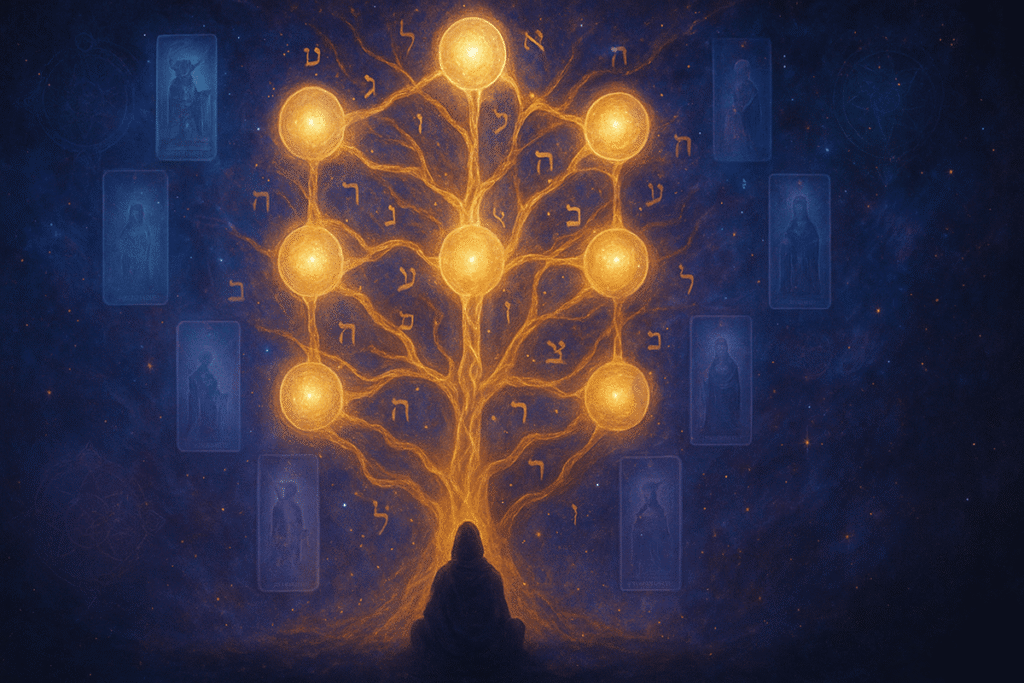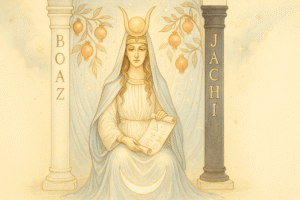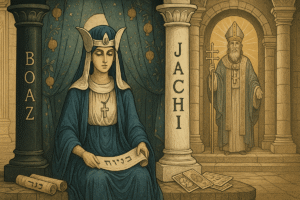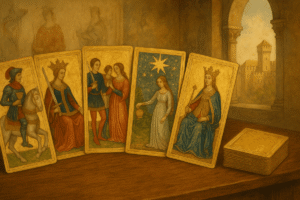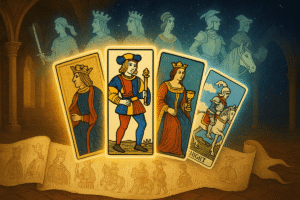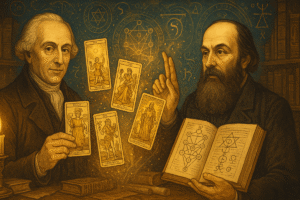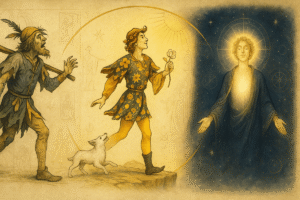Table of Contents
When I first encountered the idea that tarot cards might connect to an ancient mystical diagram called the Tree of Life, I’ll admit I felt a bit overwhelmed. Here was this intricate system with Hebrew letters, numbered spheres, and connecting paths that somehow related to the colorful cards I’d been learning about. Perhaps you’ve had a similar reaction when stumbling across references to Kabbalistic correspondences in tarot books or online discussions.
The relationship between the Tree of Life and tarot represents one of the most influential mapping systems in Western esoteric thought. This isn’t about religious doctrine or absolute truth, but rather a historical framework that many have found useful for organizing their understanding of the Major Arcana cards. Think of it as a filing system that philosophers and mystics developed over centuries to explore connections between different symbols and concepts.
Understanding the Tree of Life Structure
The Tree of Life, or Etz Chaim in Hebrew, serves as a central diagram in Kabbalistic philosophy. Picture it as a kind of roadmap with ten circular nodes called Sephiroth connected by twenty-two pathways. Each Sephira (singular of Sephiroth) represents different aspects of existence or consciousness, while the paths between them show how these qualities might flow or transform into one another.
I think what makes this system particularly interesting is how it attempts to map everything from divine concepts down to earthly experiences. The top of the tree deals with abstract, spiritual ideas, while the bottom connects to more practical, material concerns. It’s like having a cosmic organizational chart, though one that invites contemplation rather than demanding belief.
The twenty-two paths proved especially significant when tarot enthusiasts began exploring correspondences. Since the Major Arcana also contains twenty-two cards, the numerical match seemed too meaningful to ignore. Of course, this connection didn’t happen overnight. It developed through centuries of philosophical exploration and creative interpretation.
Historical Development of Tarot and Kabbalah Connections
The fascinating thing about this connection is that it’s actually quite recent in historical terms. Tarot cards emerged in 15th century Europe as playing cards, while Kabbalistic thought had been developing for much longer in Jewish mystical traditions. The marriage between these two systems really gained momentum in the 19th and early 20th centuries through the work of various occult scholars and organizations.
Perhaps the most influential figure in this development was Arthur Edward Waite, whose name you might recognize from the popular Rider-Waite tarot deck. Waite, along with members of the Hermetic Order of the Golden Dawn, spent considerable time mapping tarot symbolism onto Kabbalistic frameworks. Their work became so foundational that many modern tarot interpretations still carry traces of these correspondences, whether explicitly stated or not.
What strikes me as particularly noteworthy is how this wasn’t a matter of discovering hidden connections, but rather creating them through scholarly interpretation and creative synthesis. These thinkers looked at both systems and asked, “How might these relate to each other in meaningful ways?” Their answers became the foundation for much of what we consider traditional tarot symbolism today.
How the 22 Major Arcana Map to the Tree
The correspondence system assigns each of the twenty-two Major Arcana cards to one of the twenty-two paths connecting the Sephiroth on the Tree of Life. This creates what some describe as a journey through different states of consciousness or life experiences. The Fool, for instance, often corresponds to the path connecting the highest spiritual realm to the first emanation of divine wisdom.
When I first tried to memorize these correspondences, I found myself getting lost in the complexity. There are multiple systems, and different authors sometimes assign cards to different paths based on their interpretations of Hebrew letters or astrological associations. Rather than seeing this as confusing, I’ve come to appreciate it as evidence of the creative, interpretive nature of the whole enterprise.
The Death card might connect to a path representing transformation and renewal, while The Tower could correspond to a path involving sudden change or revelation. These aren’t predictions about your future, but rather invitations to reflect on different types of experiences we all encounter. How do you handle transformation in your own life? What role does sudden change play in your personal growth?
Some practitioners find it helpful to trace these paths on the Tree of Life diagram while contemplating their current life situations. Others prefer to focus on individual correspondences without worrying about the complete system. There’s no right or wrong approach here, which I think reflects the inherently personal nature of this kind of exploration.
Practical Applications for Modern Readers
Perhaps you’re wondering how this historical system might prove useful in contemporary tarot practice. I’ve found that understanding these correspondences can add layers of meaning to card interpretations, though they certainly aren’t necessary for meaningful tarot work. Think of them as optional tools in your toolkit rather than essential requirements.
When working with a spread, you might notice patterns in which Sephiroth or Tree of Life regions your cards correspond to. Are they clustered in areas representing practical concerns, emotional processing, or spiritual contemplation? This overview perspective can sometimes reveal themes that individual card meanings might miss.
The Tree of Life framework also offers a way to think about personal development and life experiences in organized stages. Rather than viewing challenges or opportunities as random events, you might consider them as movements along different paths of growth and understanding. What path are you currently traveling? Where might it lead, and what neighboring paths might offer alternative perspectives?
I should mention that some people find this systematic approach helpful for journaling or meditation practices. You might choose a particular path or Sephira to focus on for a week or month, using its associated tarot card as a lens for self reflection. Others prefer to let correspondences emerge naturally during readings without forcing connections.
Common Misconceptions and Balanced Perspectives
One thing I’ve noticed in discussions about Tree of Life correspondences is a tendency to treat them as either absolutely true or completely meaningless. The reality, I think, lies somewhere in between. These systems represent human attempts to find patterns and create meaning, which makes them potentially valuable without being universally applicable.
Some beginners worry they need to master Kabbalistic philosophy before working with tarot effectively. This really isn’t the case. While understanding correspondences can enrich your practice, plenty of skilled readers work primarily with intuitive approaches or other interpretive frameworks. The cards themselves contain sufficient wisdom and symbolism to support meaningful exploration regardless of which additional systems you might choose to incorporate.
Another common misconception involves treating these correspondences as ancient, unchanging truths rather than relatively recent scholarly interpretations. Recognizing their historical development helps maintain perspective on their role as interpretive tools rather than fundamental realities.
I’ve also encountered people who feel overwhelmed by the complexity of trying to learn Hebrew letters, astrological associations, and numerical correspondences all at once. If this resonates with you, consider approaching the system gradually. Maybe start by learning which cards correspond to which general areas of the Tree before diving into deeper symbolic connections.
Building Your Understanding Gradually
If you’re drawn to exploring these correspondences further, I’d suggest starting with basic Tree of Life diagrams and seeing which ones feel most accessible to your current understanding. Some versions emphasize the spiritual journey aspect, while others focus more on psychological development or creative problem solving approaches.
You might try working with one Major Arcana card and its corresponding path for several days or weeks, noting what themes or questions arise during this focused attention. How does viewing The Hermit through the lens of its Tree of Life position change your understanding compared to other interpretive approaches you’ve used?
Reading books by different authors who work with these systems can also help you see the range of interpretive possibilities. Remember that disagreement between sources doesn’t indicate error, but rather the creative, evolving nature of symbolic interpretation. What resonates with one person’s experience might not match another’s, and both perspectives can offer valuable insights.
The Tree of Life and tarot correspondences represent a rich historical tradition of symbolic exploration rather than a rigid system of absolute meanings. Whether you choose to incorporate these ideas into your practice depends entirely on what feels helpful and meaningful for your own journey of self discovery and reflection.
Conclusion
The connection between the Tree of Life and tarot offers a window into centuries of human attempts to map meaning and find patterns in existence. While these correspondences aren’t necessary for effective tarot work, they provide an additional lens through which to view the Major Arcana cards and their potential significance in our lives.
Rather than approaching this system as something to master completely, perhaps consider it as an ongoing conversation between different wisdom traditions. What questions does it raise for you? How might viewing your current circumstances through this organizational framework shift your perspective or reveal new possibilities for growth and understanding?
The beauty of working with these correspondences lies not in getting them “right,” but in allowing them to spark new connections and insights in your personal reflection practice. Whether you integrate them fully into your tarot work or simply appreciate them as interesting historical context, they represent humanity’s enduring desire to find meaning and connection in the symbols and stories that surround us.
Frequently Asked Questions
Do I need to learn Kabbalah to read tarot cards effectively?
No, understanding the Tree of Life correspondences is not necessary for effective tarot reading. Many skilled readers work primarily with intuitive approaches or focus on the card imagery itself without ever studying Kabbalistic systems. These correspondences can enrich your practice if you’re interested, but they’re optional tools rather than essential requirements for meaningful tarot work.
Why do different sources assign cards to different paths on the Tree of Life?
The correspondences you encounter vary because different occult traditions made different interpretive choices in the 19th and 20th centuries. The Golden Dawn system and Aleister Crowley’s Thoth system, for example, switched certain card assignments based on astrological and symbolic reasoning. These aren’t errors but rather reflect the creative, evolving nature of how different scholars and practitioners mapped these two systems together.
Should I start with the Major Arcana or Minor Arcana when learning Tree of Life correspondences?
Most people find it easier to start with the Major Arcana and the 22 paths, since there are fewer cards to learn and the symbolic connections tend to be more straightforward. The Minor Arcana correspondences involve understanding how the ten Sephiroth interact with the four suits, which adds another layer of complexity that’s easier to grasp once you’re comfortable with the basic Tree of Life structure.

